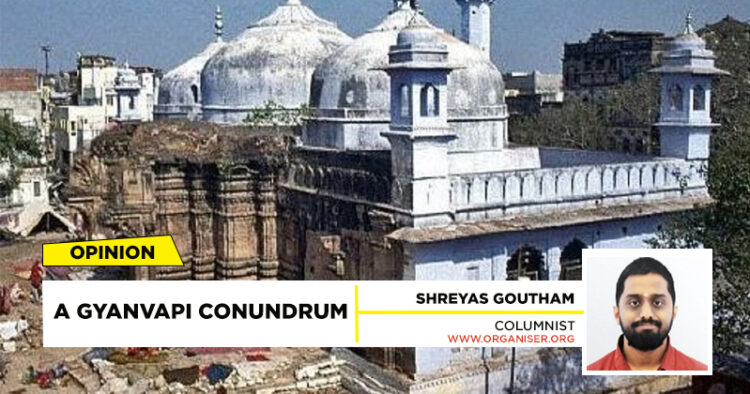The Supreme Court of India has ordered the survey of Gyanvapi without excavation or damages to the structure to Archaeological survey of India. Many petitions for the stay on the survey work have been rejected. There are two main points raised on the whole Gyanvapi issue. First is the question of the previous existence of the temple. Even if there was a temple, the legal and the constitutional position of the matter. Second is the historical narrative and its implications.
Existence of temple
There is ample proof with the historical records regarding the existence of the temple in Varanasi. The name “Gyanvapi” itself means “The well of Knowledge” in sanskrit. So from the name itself it is evident that the place is of Indian and Hindu origin. There are countless scriptures mentioning the existence of a great temple in the name of Mahadeva.
The destruction of the temple is also well documented by the court historians of Aurangzeb himself. In the book ‘Maasir-i-Alamgiri’, whose manuscript still exists, it is quoted that the Mughal emperor ordered the destruction of Kashi and Mathura temple in 1669.
The historical evidence of both existence and the destruction of the temple by Aurangzeb is beyond doubt and the findings of the Archaeological survey that is taking place would be a conclusive proof regarding existence of the physical structure hopefully be conclusive enough for the sake of reaching the truth in the highest court in India.
Legal and constitutional matters
Rationally, if the Supreme Court of India finds conclusive evidence of the demolition of the previously existing temple, the solution is pretty evident. But the workings of the Indian legal and political system are seldom so straightforward, with all the vested interests and political capital.
The major blockage in the path is quoted as places of worship act of 1991, which was brought by Narashimha rao government in the wake of Babri Masjid agitation. According to it, there would be a status quo with regards to the nature of the places of worship, and all the litigations regarding this would be null and void. The only exception given is the Ram Janmabhoomi issue.
So according to this act, the right of any hindu to even appeal against the atrocities against him and appeal for restoration of his basic right to religion is unconstitutional. How can a country which assures justice for all its preamble justify itself if even the right to appeal regardless of what conclusion is reached is taken away from its citizens? Even a person who is adjudged as a terrorist is given multiple chances to appeal to higher courts, but a citizen’s appeal for his fundamental right is perceived to be unconstitutional and illegal.
The effect of the prevalent narrative of history, which was popularised and propagated by the political class with a certain ideological leanings from the initial days of independence, has brought the country to a situation where the right to worship of Hindus isnt even eligible for appeal in courts. It will be interesting to watch the proceedings in the light of this and how the courts interpret the act, when the overwhelming evidence is placed before them and reach the judgement.
Historical narrative
Notwithstanding the constitutional and political matters, the more distressing thing is the historical narrative that is prevalent in our country. The debate in public when the photo inside Gyanvapi went viral is if the structure found in Gyanvapi is either Shivling or fountain. The trivialising of the issue by oversimplifing it so such details and participation of the citizens is concerning at the least.
Whitewashing of Indian history for the sake of greater good of communal and religious harmony is well documented. This whitewashing is not without its consequences. The idolising of bigots like Aurangazeb or Tipu Sultan by the youth of our country is just a small example. The continuation of this is the acceptance of horrible atrocities done by these tyrants as a moral standard of the medieval times. For example the much quoted and horrific destruction of temples by the islamic invaders is brushed off as a normal practice done by all the rulers of the time. But there is no record of Chatrapathi Shivaji Maharaj destroying any mosques inspite of all the acrimonious relationship with Mughals and his pursuit of Hindu Rashtra. Even the father of Tipu Sultan, Haider Ali was not so fanatic, that he would destroy temples and convert people.
The left leaning historians in their zeal to integrate the acts of the brutal invaders with the culture of this land leave no stone unturned to justify them.The Jiziya tax, which is an extra burden on the “idol worshiping kafirs” to make their life more tough, a way to arm twist them into converting is defined as just a way to raise funds for the empire. The reason is quoted as purely economical with no malafide religious intentions behind it. The buring of Nalanda temple was nothing more than a political and war tactic according to our history textbooks. It would be interesting to see if there were any soldiers or rulers hiding behind the huge pile of books in the library for him to burn the knowledge centre to the ground.
Let it go?
The other peace loving group exists in this country, which always asks the Hindus to let go of the past and look for the future. To forget all the atrocities, they have been through without a chance of consolidatary justice. It is important to note that the seeds of the future are buried in the past. A person who idolises these bigots can never understand the true meaning of “Sarva Dharma Samabhav”, which is the ideal of the Indian secularism. So, the struggle for Gyanvapi and Shri Krishna Janmabhoomi must be looked as a true acceptance of Indian history with all its uncomfortable truth and struggle for the dharma upon which a bright future must be built.




















Comments